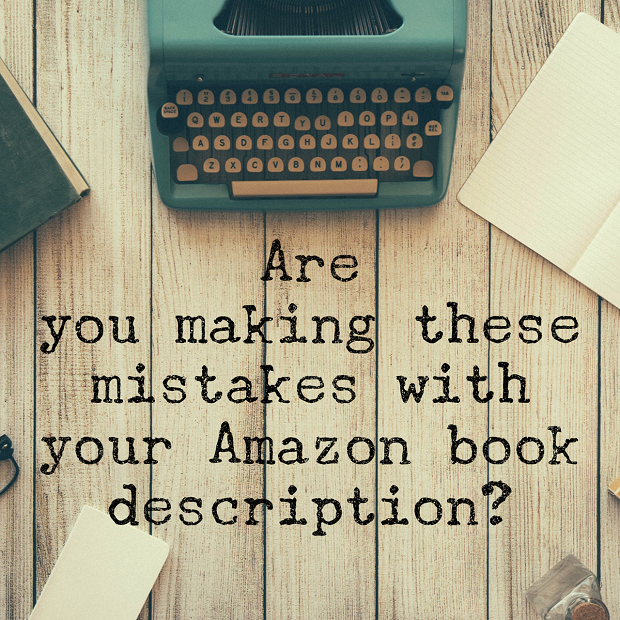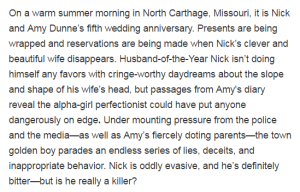Are you making these mistakes with your Amazon book description?
What’s the first thing you do when you search for a book on Amazon and find one that could be just what you want or need?
If you’re like most, you read the Amazon book description at the top of the page.
That’s because you’re looking for specific information. If you can’t find it, you go on to the next book in the search results.
3 common mistakes
That book description is the reader’s gateway to your book — it’s what convinces a reader that your book is the solution to their problem. And yet, so many authors and publishers slap up something quick and vague — using as few as two sentences sometimes — on the most valuable real estate on your Amazon’s sales page.
Is it time for you or your publisher to revisit your description to make sure it meets reader expectations? Here are three common mistakes you’ll want to look for in yours.
1. It doesn’t answer the question, “What is the book about?”
It seems obvious, but sometimes that question isn’t answered. Oh, the words are there, but they don’t say enough for a reader to make a decision. Sometimes, the author is too focused on appearing literary. In other cases, a nonfiction book is described in two sentences, but needs 10.
2. It doesn’t have enough information or what’s there isn’t helpful.
Sometimes it’s not clear if the book is fiction or a memoir. Some nonfiction book descriptions are misleading — they over-promise and the book under-delivers, so the reader is disappointed. Disappointment leads to negative reviews and bad word-of-mouth.
BookBub, the company that sells discounted books through targeted daily email newsletters, offers helpful information from its research in an article on its site, “How to improve your description copy to sell more ebooks.”
One key tip: Help readers recognize themselves in your description by using phrases such as, “Fans of cozy mysteries about cats with magical whiskers will love this book.”
With nonfiction, be clear, concrete, and specific. How many methods does the book offer for retiring before we’re 50, or how many illustrations are there in the “turn your trash into treasures” crafting book? Use bullet points to detail what we’ll learn from reading it.
For both fiction and nonfiction, make sure you include the keywords that will help your book get discovered in a search.
3. It has so many spelling, grammar, or capitalization mistakes that the reader knows the book will be hard to read.
If reading the description makes book buyers wince, they will never make it through the book — and they know it. Errors in the book’s description indicate that the book will be full of them, too. If the writer can’t spell, can she write? Maybe, but mistakes are distracting and diminish the reader’s enjoyment.
What’s more, if the author doesn’t care enough to present a polished book description, will she care enough to make sure the facts in a nonfiction book are accurate?
There are so many books available. People don’t need to bother with books that signal upfront that the author didn’t care enough (or know how) to proofread the description.
Fixing the problems
Fortunately, improving your book’s description isn’t hard. Try these ideas:
Study descriptions for books by mainstream publishers in your genre. The large, established publishers have this figured out. The best-sellers page for your category on Amazon is a good starting point, too. Click through on the books to read their descriptions and analyze the various elements. Are any of them missing from yours?
What about keywords? Did you incorporate them into your description so your book gets found there?
Here’s the description for one of my favorites, Gone Girl.
It gives you two key pieces of information quickly: You learn what the book’s about, and you know it’s well-written.
Add to cart.
After you or your publisher have written yours, show it to a few people who know about your book. Ask them if the description is accurate, interesting, and compelling. Would it encourage them to buy the book? Do the same with a couple of people who aren’t familiar with the book, asking the same questions.
Pay an editor to proofread and polish your description. (And, if you haven’t done so, pay somebody to edit your book, too!)
Your book’s description on any online retail site should be working hard to sell the book for you. If it isn’t, fire it and get a new one.
Learn more about how to optimize your book’s Amazon page in the Build Book Buzz training program, “How to Sell More Books on Amazon.” Amazon sells 75 percent of the books purchased online, so you can’t afford to make mistakes there.
What catches your attention in an online book description?
Like what you’re reading? Get it delivered to your inbox every week by subscribing to the free Build Book Buzz newsletter. You’ll also get my free “Top 5 Free Book Promotion Resources” cheat sheet immediately!



Descriptions absolutely make a difference. I looked at several before deciding to take excerpts from my books. This gives specific tips on what will be found inside. I also use at least 4000 characters.
That was very smart, Virginia. Thanks for sharing!
Sandy
One thing I have noticed is that many book blurbs contain too many spoilers. They are more like summaries than incentives. If readers are told beforehand the conflicts your characters encounter in the story, why would they want to read the book?
Publishers need to be aware of this fact, as many of them provide blurbs that give away way too much of the story. I’ve written an extensive article on these kinds of blurbs. With the blurb being the first point of contact most readers have with your story, if they read it and get the feeling of “It feels like I just finished reading this book” or “I would like to have discovered those things for myself,” then they’re not even going to get to the preview.
http://www.kathysnotes.com/blog/is-your-book-blurb-too-blabby
Thanks, Kathy. I know you didn’t see Anne’s comment before you wrote this, but she clearly agrees. (And I love the title of your article — thanks for that link!)
Sandy
I wholeheartedly agree!
With book descriptions for works of fiction, there’s a fine line an author must walk and I can’t stress that enough. It’s wonderful to give the reader an overview of what your novel is about but you can say too much and give too much of the plot away.
There’s no need in any description to give a blow by blow of the major plot points. There’s no need to relate much, if any of the backstory. For fiction, you really need a one or two sentence teaser (an elevator pitch), followed by a paragraph or two that lays out the overall premise of the story. You don’t always even need to name your main characters.
Excellent advice, Anne. Thank you for weighing in.
Sandy
Hi, Anne, Sandra just pointed out your comment to me. Right on, is what I say. I have skipped over so many books because the blurb ruined any further interest in the story. I’ve even contacted some authors about making changes, but I’ve learned that most authors don’t like being told they need to fix their blurbs, so I gather they aren’t taking into account the potential readers they’re losing.
I agree. There are a lot of authors that don’t like to hear that what they’ve done is hurting them. Not being marketers by trade, they seem to think they’re helping their cause by telling all.
I have the same issue with reviewers that give the blow by blow of the book. I’ve all but given up on a genre specific Goodreads group I belong to because that’s what the group admin and another reader do. They think they’re doing the group members a service but they make me – and likely others – feel like there isn’t any need to read the books, even when they liked what they’ve reviewed.
A nice article and sharing
Thanks…
Thank you, Chip.
Sandy
My experience is similar to Kathy Golden’s: Authors are far more likely to say too much than too little in their blurbs. The trick is telling potential readers just enough to make them curious.
http://covertocoverllc.com/blog/?p=184
Thank you, Susan. I clicked through on the link — I love the look of your site! Do you write cover descriptions for authors? I sometimes hear from authors asking for a referral for that.
Sandy
Thank you! Yes, I do write cover descriptions for authors. If anyone asks you for a referral, please feel free to send them my way.
Perfect! Thanks!
Sandy
Excellent! Thank you!
Thanks, Kim. I hope it was helpful.
Sandy
Putting review quotes first. I want to know what the book is about before reviews. If I have to scroll through to find it, I often just pass.
Great tip, Jaq. Thanks!
Sandy
Just want to say thanks for the article Sandra, and I also appreciate the follow-up comments & replies. No. 1 is an area that I need to focus on, and not to write a mini-novel to describe key elements of the book!
best wishes
Suzanne
I’m glad it was helpful, Suzanne. I’m grateful for those extra comments, too. Thanks for the feedback.
Sandy
Great article, thanks! I especially like the advice about looking at bestsellers in your genre and having others who read (and didn’t read) your book critique it. Now, onto finalizing my description before showing it to people! 😃
I’m glad it’s helpful. Take your time with all of this — it’s really important!
Sandy